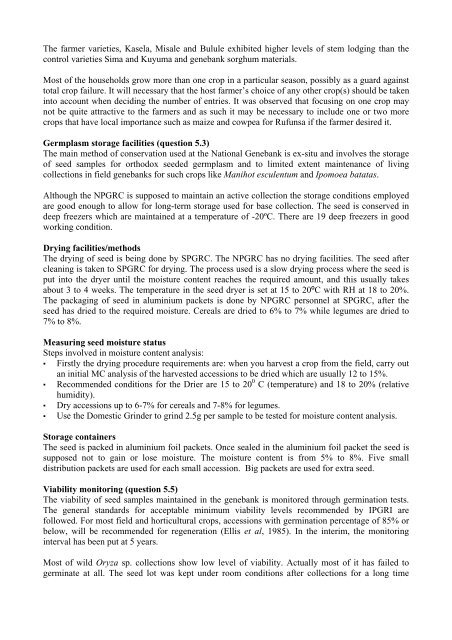Improving the identification, handling and storage of âdifficultâ seeds ...
Improving the identification, handling and storage of âdifficultâ seeds ...
Improving the identification, handling and storage of âdifficultâ seeds ...
Create successful ePaper yourself
Turn your PDF publications into a flip-book with our unique Google optimized e-Paper software.
The farmer varieties, Kasela, Misale <strong>and</strong> Bulule exhibited higher levels <strong>of</strong> stem lodging than <strong>the</strong><br />
control varieties Sima <strong>and</strong> Kuyuma <strong>and</strong> genebank sorghum materials.<br />
Most <strong>of</strong> <strong>the</strong> households grow more than one crop in a particular season, possibly as a guard against<br />
total crop failure. It will necessary that <strong>the</strong> host farmer’s choice <strong>of</strong> any o<strong>the</strong>r crop(s) should be taken<br />
into account when deciding <strong>the</strong> number <strong>of</strong> entries. It was observed that focusing on one crop may<br />
not be quite attractive to <strong>the</strong> farmers <strong>and</strong> as such it may be necessary to include one or two more<br />
crops that have local importance such as maize <strong>and</strong> cowpea for Rufunsa if <strong>the</strong> farmer desired it.<br />
Germplasm <strong>storage</strong> facilities (question 5.3)<br />
The main method <strong>of</strong> conservation used at <strong>the</strong> National Genebank is ex-situ <strong>and</strong> involves <strong>the</strong> <strong>storage</strong><br />
<strong>of</strong> seed samples for orthodox seeded germplasm <strong>and</strong> to limited extent maintenance <strong>of</strong> living<br />
collections in field genebanks for such crops like Manihot esculentum <strong>and</strong> Ipomoea batatas.<br />
Although <strong>the</strong> NPGRC is supposed to maintain an active collection <strong>the</strong> <strong>storage</strong> conditions employed<br />
are good enough to allow for long-term <strong>storage</strong> used for base collection. The seed is conserved in<br />
deep freezers which are maintained at a temperature <strong>of</strong> -20ºC. There are 19 deep freezers in good<br />
working condition.<br />
Drying facilities/methods<br />
The drying <strong>of</strong> seed is being done by SPGRC. The NPGRC has no drying facilities. The seed after<br />
cleaning is taken to SPGRC for drying. The process used is a slow drying process where <strong>the</strong> seed is<br />
put into <strong>the</strong> dryer until <strong>the</strong> moisture content reaches <strong>the</strong> required amount, <strong>and</strong> this usually takes<br />
about 3 to 4 weeks. The temperature in <strong>the</strong> seed dryer is set at 15 to 20ºC with RH at 18 to 20%.<br />
The packaging <strong>of</strong> seed in aluminium packets is done by NPGRC personnel at SPGRC, after <strong>the</strong><br />
seed has dried to <strong>the</strong> required moisture. Cereals are dried to 6% to 7% while legumes are dried to<br />
7% to 8%.<br />
Measuring seed moisture status<br />
Steps involved in moisture content analysis:<br />
▪ Firstly <strong>the</strong> drying procedure requirements are: when you harvest a crop from <strong>the</strong> field, carry out<br />
an initial MC analysis <strong>of</strong> <strong>the</strong> harvested accessions to be dried which are usually 12 to 15%.<br />
▪ Recommended conditions for <strong>the</strong> Drier are 15 to 20 0 C (temperature) <strong>and</strong> 18 to 20% (relative<br />
humidity).<br />
▪ Dry accessions up to 6-7% for cereals <strong>and</strong> 7-8% for legumes.<br />
▪ Use <strong>the</strong> Domestic Grinder to grind 2.5g per sample to be tested for moisture content analysis.<br />
Storage containers<br />
The seed is packed in aluminium foil packets. Once sealed in <strong>the</strong> aluminium foil packet <strong>the</strong> seed is<br />
supposed not to gain or lose moisture. The moisture content is from 5% to 8%. Five small<br />
distribution packets are used for each small accession. Big packets are used for extra seed.<br />
Viability monitoring (question 5.5)<br />
The viability <strong>of</strong> seed samples maintained in <strong>the</strong> genebank is monitored through germination tests.<br />
The general st<strong>and</strong>ards for acceptable minimum viability levels recommended by IPGRI are<br />
followed. For most field <strong>and</strong> horticultural crops, accessions with germination percentage <strong>of</strong> 85% or<br />
below, will be recommended for regeneration (Ellis et al, 1985). In <strong>the</strong> interim, <strong>the</strong> monitoring<br />
interval has been put at 5 years.<br />
Most <strong>of</strong> wild Oryza sp. collections show low level <strong>of</strong> viability. Actually most <strong>of</strong> it has failed to<br />
germinate at all. The seed lot was kept under room conditions after collections for a long time

















